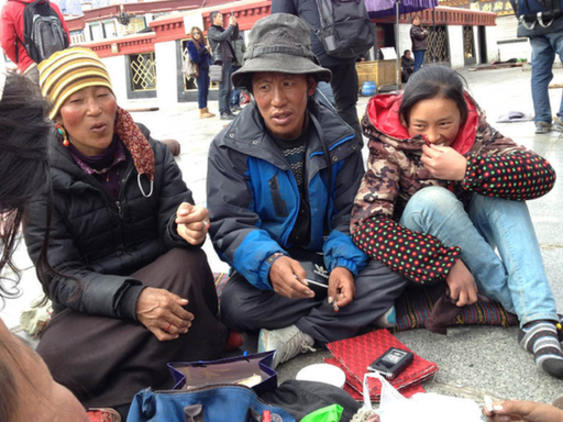Lhasa Transformed
By staff reporter ZHANG HONG
Thirteen–year–old Tenpai Nyima and his parents are relaxing on the doorstep of Jokhang Monastery, more than 2,800 kilometers from their hometown in Sichuan Province.
Two months ago, the family completed a pilgrimage from their hometown to Lhasa, a 230-day journey on foot during which they ritually prostrated themselves every three steps. When they finally reached the square of the famous Jokhang Monastery, they sat down, exhausted, and reflected on their achievement.
Tenpai had stayed in touch with friends back home during this tedious journey through his mobile phone and Internet. Thanks to social networking he could share his experience with people around the nation and beyond.
Not far away, Ang Zhehai, 74, and his wife from neighboring province Qinghai are circumambulating, the ritual of circling the monastery and praying. The couple are on their third pilgrimage to Lhasa. Ang’s first was 62 years ago as a boy of 12; it took him five months to reach Lhasa by ox cart. After construction of the Qinghai-Tibet Highway, 58–year–old Ang’s second trip took only four days. Now the drive from his hometown Xining to the Tibetan capital has been reduced to overnight.
|
 |
|
Tenpai Nyima and his family in Lhasa in Febuary 2014. Zhang Hong |
Renovating the Old District
Over the past years marked changes have occurred not only in the transportation system to Lhasa and other Tibetan cities, but also the cities themselves.
On March 2, 2014, Barkhor Street, a time-honored path around the Jokhang Monastery that is packed with pilgrims and tourists all year round, celebrated the first Tibetan New Year after its renovation. Although most of the shops were shut for the holiday, the area was still inundated with pilgrims. New street lamps warmly lit the streets, which were paved with slate instead of flagstones. According to Cao Pengcheng, deputy director of the Barkhor Street Management Committee, these hard slates, from mountains 5,000 kilometers above sea level in Shannan Prefecture in southern Tibet, allow the old district to retain its native simplicity.
Formerly, the Jokhang Monastery was surrounded by more than 3,000 outdoor vendors, who cluttered the narrow circumambulation paths with their wares. They are now in the newly opened Barkhor Shopping Mall. It enables them to do business rain or shine, and meanwhile makes room for pilgrims circling the monastery.
This change is a direct result of the conservation works of Lhasa’s old district, launched at the end of 2012. With an investment of RMB 1.5 billion, the six-month project has comprehensively advanced the infrastructure of Barknor Street.
“In the past, both sides of the street were crammed with stands, which made it difficult for pedestrians to pass. Vendors had to do business in the open, and move goods by tricycle every day,” recalled Cao. “Now, the less crowded streets make things easier for worshipers. Besides, there is also no need to ferry goods back and forth every day, because sellers can store their wares in the shopping mall. “
To preserve Lhasa’s traditional features, the local authority requires that any reconstruction or renovation of old buildings in this 1.33-square-kilometer area must keep to the old architectural style.
The conservation works have also upgraded Barkhor Street’s electricity system. According to Cao, most of the buildings in the 1,400-year-old district are wooden constructions. Before the conservation works, electric cables were tangled and interwoven, with unstable voltage. A single high-powered appliance could cause a blackout. Electricians had to check the wiring before every festival or holiday.
Today the entire area has been rewired. Old utility poles have been replaced with pad-mounted transformers to eliminate the fire hazard. “Currently the circuits are stable and safe,” remarked 48-year-old Dorhe, head of a local neighborhood committee. Dorhe formerly had to come into the office every holiday in case of fire hazards.
